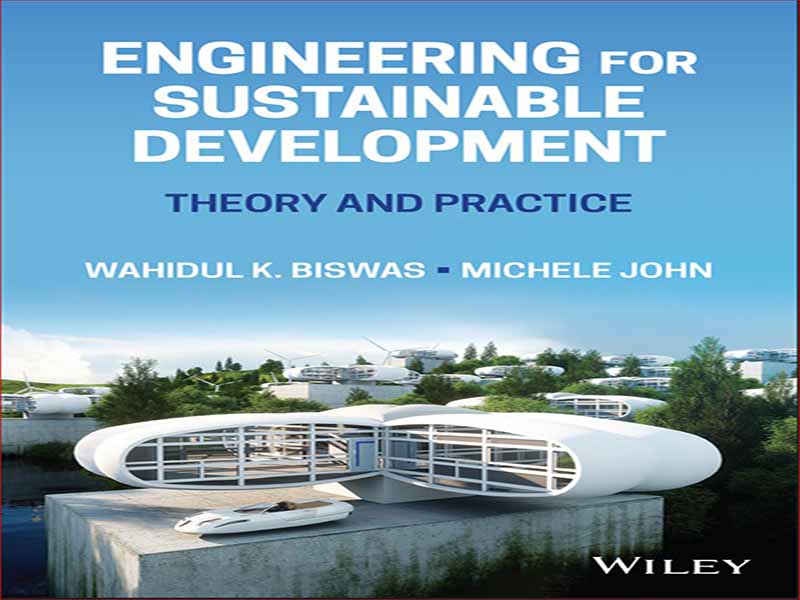- عنوان کتاب: Engineering for Sustainable Development / Theory and Practice
- نویسنده: Wahidul-K.-Biswas,-Michele-John
- حوزه: توسعه پایدار
- سال انتشار: 2022
- تعداد صفحه: 355
- زبان اصلی: انگلیسی
- نوع فایل: pdf
- حجم فایل: 5.49 مگابایت
مهندسی برای توسعه پایدار هم امید و هم چالش هایی را برای قرن بیست و یکم به همراه دارد. آخرین گزارش IPCC (2021) بیان می کند که دمای سطح جهانی تحت همه سناریوهای انتشار حداقل تا اواسط قرن به افزایش ادامه خواهد داد. واضح است که گرمایش جهانی 1.5-2 ∘C در طول قرن بیست و یکم بیشتر خواهد شد، مگر اینکه کاهش قابل توجهی در انتشار دی اکسید کربن و سایر گازهای گلخانه ای در چند دهه آینده ایجاد شود. این برای حرفه مهندسی چه معنایی دارد؟ این بدان معناست که فناوریها، انتخابهای مواد و طرحهای مهندسی همگی با فشارهای فزایندهای برای بهبود بهرهوری انرژی، حرکت به سمت انرژیهای تجدیدپذیر، کاهش انرژی و شدت مواد در محصولات و خدمات مهندسی، و در نظر گرفتن کاهش مدیریت پسماندهای پایان عمر، با فشارهای فزایندهای مواجه خواهند شد. مشکلات از طریق بهبود طراحی، بازیابی منابع و ساخت مجدد. همچنین به این معنی است که حرفه مهندسی باید به طور جدی مسئولیتهای اجتماعی و مسئولیتهای اجتماعی زندگی در دنیایی را که در اواسط قرن ۹ میلیارد نفر در آن زندگی میکنند و تمام فشارهای ناشی از گرم شدن آب و هوا و افزایش تراکم جمعیت در شهرهای بزرگ ما در نظر بگیرد. و مبادلات دائمی بین افزایش رشد اقتصادی و حفظ منابع جهانی و محیط طبیعی. همه این چالش ها در تصمیم گیری مهندسی است. همانطور که توسط پروژه لبه طبیعی (2002-2006) مشخص شده است، 70٪ از چالش های پایداری مدرن اساساً شامل تصمیم گیری مهندسی می شود. مهندسی طیف گسترده ای از کاربردهای صنعتی، بخش های تولیدی، تولید کالاهای مصرفی و سیستم های مسکن و انرژی را پوشش می دهد. مهندسان در انقلاب صنعتی قرن هفدهم مرکزی بودند که سیستمهای تولید فشرده قرن قبل را که از نظر سلامتی بهبود یافته، استانداردهای زندگی بالاتر و رشد اقتصادی جهانی و توسعه فنآوری فوقالعاده بهرهمند بودند، تسریع کردند. ما باید از حرفه مهندسی برای این تشکر کنیم.
Engineering for sustainable development brings both hope and challenges for the twenty-first century. The latest IPCC (2021) Report states that global surface temperatures will continue to increase under all emission scenarios until at least the mid-century. It is clear that global warming of 1.5–2 ∘C will be exceeded during the twenty-first century unless significant reductions in carbon dioxide and other greenhouse gas emissions are made in the next few decades. What does this mean for the engineering profession? It means that the technologies, material choices, and engineering designs will all face increasing pressures to improve energy efficiency, to move towards only renewable energy, reduce embodied energy andmaterial intensity in engineering products and services, and consider reducing end-of-life waste management issues through improved design, resource recovery, and remanufacturing. It also will mean that the engineering profession will need to seriously consider the stewardship and corporate social responsibilities of living in a world destined for 9 billion people by mid-century and all the attendant pressures of a warming climate, increased population density in our major cities, and the constant trade-offs between increased economic growth and the conservation of global resources and the natural environment. All these challenges are grounded in engineering decision-making. As highlighted by the Natural Edge Project (2002–2006), 70% of modern sustainability challenges fundamentally involve engineering decision-making. Engineering covers a wide variety of industry applications, manufacturing sectors, consumer good production, and housing and energy systems. Engineers were central to the seventeenth century Industrial Revolution which catalysed the intensive production systems previous century have benefited from in terms of improved health, higher living standards and phenomenal global economic growth and technological development. We have the engineering profession to thank for this.
این کتاب را میتوانید از لینک زیر بصورت رایگان دانلود کنید:
Download: Engineering for Sustainable Development / Theory and Practice



































نظرات کاربران